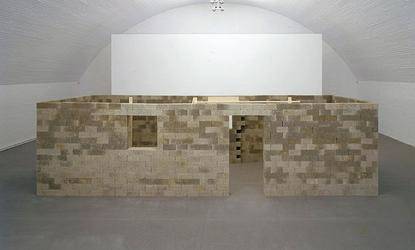Georg Herold
06 May - 25 Jun 2005
Holzmarktstraße 15 - 18 / S-Bahnbogen 48
Georg Herold
06 May - 25 June 2005
Galerie Max Hetzler is pleased to present an exhibition of the sculpture X. Baracke, 1986, by Georg Herold from May 6 to June 25, 2005 at Holzmarktstraße 15-18, S-Bahnbogen 48, Berlin-Mitte.
Jörg Heiser: Why "X. Baracke"?
Georg Herold: X as in ten, as in the 10th Station of the Cross. But no one noticed this, quite determinedly so, which surprised me. For me it is above all about the massive wall of stone, about a certain very simple physical presence. And about architecture and construction, since inside it is a frame made of squared timber. Fixed to a wall inside the barrack is a photo which I took in Belgium of a mouldy decaying church. Nothing but a terse cardboard sign announces that the 10th Station of the Cross is in the process of being restored.
JH: So that makes double sense. The nasty little cardboard sign and the 10th Station at which Jesus is stripped of his clothes. The barrack is a modern ruin, no longer a relic but something that never actually came about.
GH: The barrack as a synonym for disaster.
JH: In Germany one is of course immediately reminded of concentration camps. It also makes me think: bring Gerhard Merz back down to earth.
GH: That's my agenda anyway. Knocking things off their pedestals. For instance, Skulptur vom Sockel erschlagen (Sculpture knocked off by pedestal, 1992) is one work that explicitly does this.
JH: The problem seems to be that "poor" materials can easily be used to create a sense of the sublime and of aura – just take Beuys. In this respect, your approach is a counter-programme.
GH: I was always more one of those who take an inventory of the real. Not of the elevated kind, just the naked facts. That's also my attitude to the issue of "coming to terms with the past". The past is not come to terms with, it simply remains the present. This is at play in a piece like X. Baracke: we aren't living somewhere else today, we're living in precisely the same place – and in this past moment as well.
[Jörg Heiser in conversation with Georg Herold, excerpt from the book: Georg Herold, X. Baracke, 1986, published by Holzwarth Publications Berlin, 2005, on the occasion of the exhibition Georg Herold, X. Baracke at Galerie Max Hetzler, Berlin]
The sculpture X. Baracke, 1986, pumice stone, wood, photograph, 190 x 200 x 700 cm, was shown for the first time in 1986 at Westfälischer Kunstverein (Münster); it was then exhibited in 1992 at Documenta IX (Kassel) and at the Institute of Visual Culture (Cambridge) in 2003.
Georg Herold, born 1947 in Jena, lives and works in Cologne. He exhibits at Galerie Max Hetzler since 1984.
The exhibition is accompanied by a catalog, published by Holzwarth Publications.
For further information, please contact the gallery at 030-229 24 37
Georg Herold
06 May - 25 June 2005
Galerie Max Hetzler is pleased to present an exhibition of the sculpture X. Baracke, 1986, by Georg Herold from May 6 to June 25, 2005 at Holzmarktstraße 15-18, S-Bahnbogen 48, Berlin-Mitte.
Jörg Heiser: Why "X. Baracke"?
Georg Herold: X as in ten, as in the 10th Station of the Cross. But no one noticed this, quite determinedly so, which surprised me. For me it is above all about the massive wall of stone, about a certain very simple physical presence. And about architecture and construction, since inside it is a frame made of squared timber. Fixed to a wall inside the barrack is a photo which I took in Belgium of a mouldy decaying church. Nothing but a terse cardboard sign announces that the 10th Station of the Cross is in the process of being restored.
JH: So that makes double sense. The nasty little cardboard sign and the 10th Station at which Jesus is stripped of his clothes. The barrack is a modern ruin, no longer a relic but something that never actually came about.
GH: The barrack as a synonym for disaster.
JH: In Germany one is of course immediately reminded of concentration camps. It also makes me think: bring Gerhard Merz back down to earth.
GH: That's my agenda anyway. Knocking things off their pedestals. For instance, Skulptur vom Sockel erschlagen (Sculpture knocked off by pedestal, 1992) is one work that explicitly does this.
JH: The problem seems to be that "poor" materials can easily be used to create a sense of the sublime and of aura – just take Beuys. In this respect, your approach is a counter-programme.
GH: I was always more one of those who take an inventory of the real. Not of the elevated kind, just the naked facts. That's also my attitude to the issue of "coming to terms with the past". The past is not come to terms with, it simply remains the present. This is at play in a piece like X. Baracke: we aren't living somewhere else today, we're living in precisely the same place – and in this past moment as well.
[Jörg Heiser in conversation with Georg Herold, excerpt from the book: Georg Herold, X. Baracke, 1986, published by Holzwarth Publications Berlin, 2005, on the occasion of the exhibition Georg Herold, X. Baracke at Galerie Max Hetzler, Berlin]
The sculpture X. Baracke, 1986, pumice stone, wood, photograph, 190 x 200 x 700 cm, was shown for the first time in 1986 at Westfälischer Kunstverein (Münster); it was then exhibited in 1992 at Documenta IX (Kassel) and at the Institute of Visual Culture (Cambridge) in 2003.
Georg Herold, born 1947 in Jena, lives and works in Cologne. He exhibits at Galerie Max Hetzler since 1984.
The exhibition is accompanied by a catalog, published by Holzwarth Publications.
For further information, please contact the gallery at 030-229 24 37

